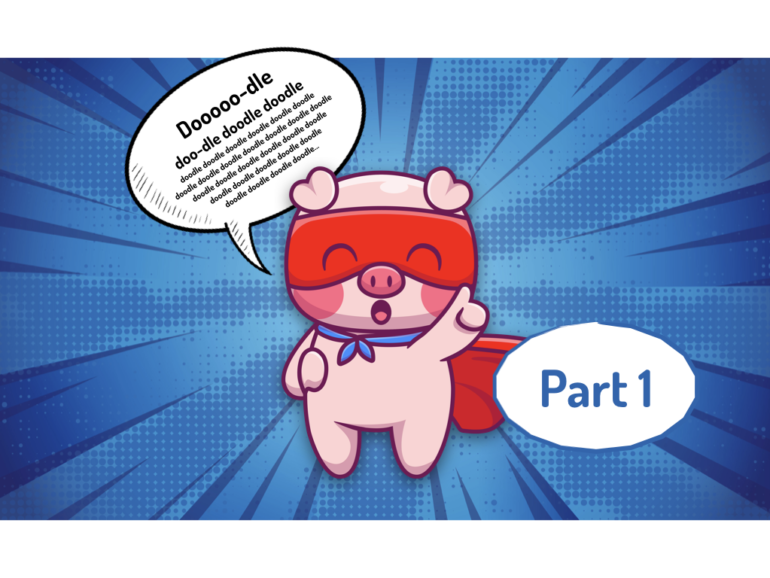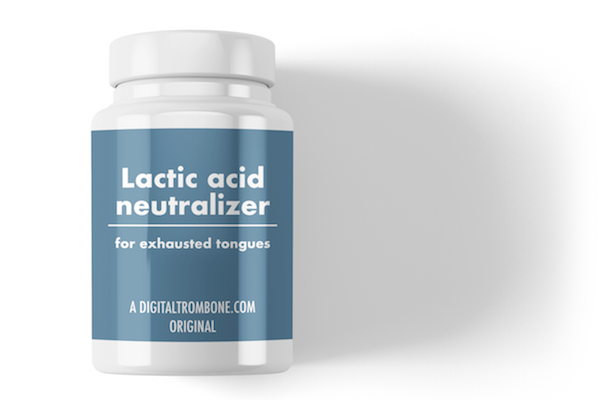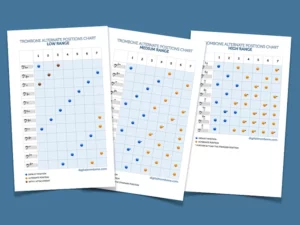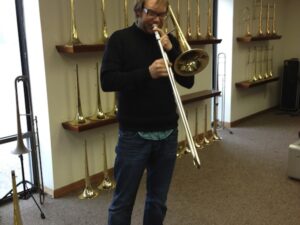
Introduction to trombone doodle tonguing
A crash course with seven steps to doodle heaven
If you are a trombone player with some interest in jazz, chances are that you heard about doodle tonguing or use it already. It is a (primarily) jazz articulation technique that enables you to play fast lines smoother and more legato than with double tongue (this is NOT an illustration of double tongue for brass players!). Trumpet doodle tongue is basically the same technique, so keep reading, dear brass siblings.
Playing fast lines on the trombone is actually more a question about articulation than being able to move slide fast enough. Since trombones don’t have keys or valves, we have to articulate differently than other wind players; tonguing most notes, combined with natural legato when possible.
Double tongue (staccato) vs. doodle (legato)
Where double tongue is well suited for fast marcato and staccato playing, doodle tongue is perfect for fast legato playing. If you are a jazz player, you probably know that double tongue just doesn’t sound right when you play a fast line of swing eights. It is hard to get the swing phrasing right, and the notes get too short. With doodle tonguing, there is kind of a built-in swing phrasing that makes it perfect for jazz, although you can still play perfectly even eights.
Some players have a really fast single tongue, and hardly ever use or need double or doodle tonguing, but if you (like me) are not one of them, you will find trombone doodle tongue playing very helpful. I use doodle tonguing a lot combined with natural legato – I would not be able to play a lot of what I play without this technique. It was a real life-changing (ok, trombone-changing…) moment when I first learned about doodle tonguing, and it opened up a whole new world of possibilities for me on my horn!
Practice with a bit of caution
Be aware when working on doodle tongue – you shouldn’t do it for hours in a row. That will give you a lot of lactic acid in your tongue. Although a completely harmless sensation, it does affect your playing for a while, so no major doodle workouts just before getting on stage (been there, done that, bad idea). But there is a simple solution ?

Trombone tonguing techniques
There are three main tonguing techniques that I will cover here, each suitable for different purposes.
- Single tongue – the standard tonguing technique. Du-du-du or tu-tu-tu. Each note is tongued equally. This is how you play most of the time.
- Double and triple tonguing – the go-to method for fast staccato playing especially in classical trombone music. Tu-ku-tu-ku (double tonge) or tukutu-tukutu-tukutu (triple tongue).
- Doodle tonguing – this high-speed legato tonguing is especially widespread among jazz players. When mastered, it enables you to play blistering fast smooth legatos. Do-dl-do-dl or as triplets: do-dl-do do-dl-do.
The difference between the three main trombone tonguing techniques single tongue, double tongue, and doodle tongue, is this:
Single tongue
tu-tu-tu-tu or du-du-du-du
Double tongue
tu-ku-tu-ku or du-gu-du-gu
Doodle tongue
do-dl do-dl do-dl do-dl
Have you guessed why it is called doodle yet? ?
If you are just starting to learn doodle tongue, I highly recommend that you take a few lessons in person with an experienced teacher who is familiar with the technique to make sure that you get it right from start. You don’t want to mess up your sound or embouchure in the pursuit to play lightning-fast, smooth legatos.
Seven steps to doodle heaven
The ONLY way to become good at doodle tonguing and actually being able to use it in your playing is to PRACTICE SLOW! Here are some basic exercises you can use to get the first feel of doodle tonguing.
1. Say it out loud in different tempi (ranging from stupid slow to reasonably slow) “doodle doodle doodle doodle doodle doodle…” Makes sure the -dle part sounds and feels as open as the doo-part. Since the tip of your tongue is stuck in the top of your mouth, the air has to find its way around it. Your tongue will need to practice this quite a lot in order to make the difference in sound between doo and dl as small as possible. Do it on the bus, in the car, in the elevator, in the shower, in bed (alone…). Gradually say it faster and faster without stumbling or loosing clarity.
2. Air and correct embouchure. Still no horn. Now repeat the word doodle real slow but with only air. Your lips should be formed as if you were to play in a medium range. Listen to how the air sounds when you say doo and try to get the same sound on the -dle part. You do not want the -dle part to have a hissing sound. Try holding your hand in front of your mouth and feel the airflow. Compare the feel of the air on your hand with a normal tu-tu tongue and doodle tongue. If there is a big difference, try to make the doodle-air stream feel as smooth as the single tongue air stream. This is tricky in the beginning for most. Don’t underestimate this step.
3. NO! You are not ready to move on yet. Go back to step 2 and put in some more work.
4. Try it on your trombone. Just pick any mid-range note and try it real slow. I recommend only using the range between low C and middle C. Lower than that tends to get messy in the beginning, and the higher range is harder to control in the beginning without compromising your sound.
5. Minimize sound differences! In the beginning, you will probably experience that the second half of the articulation (the -dl part) tends to disappear or be more slurry than the first part. Just keep the tempo very slow until you get a decent attack on both doo and -dl. Try ending on a long note both on doo and -dl and try to make them both sound the same despite the tongue being in the way when you start a long note with the dl attack.
6. Track down a teacher who uses doodle tonguing to help you hands-on.
7. Check out Doodle Tonguing – Part 2!
Examples of trombone doodle playing
Yours truly (Anders Larson) playing on my album Cars
I couldn’t possibly play this uptempo theme without doodling. Enjoy Gerard Presencer’s trumpet playing as well, he is an amazing horn handler.
Bill Watrous in action
Carl Fontana
Check out the part where he plays on his own, it’s so smooth and elegant!
Conrad Herwig and Peter Dahlgren
Two doodle masters (trombone solos start at 3:55)
Elliot Mason
in What Is This Thing Called Love
13 Comments
-
Hello!
I miss at least one important name here: Bob McChesney, who has written a study for doodle tonguing called “Doodle studies and etudes” which in very small steps teach doodle tonguing.
Check it out at his website.
As an old hobby player I came across this just a couple of years ago and I have come halfway. It has helped me a lot.
I actually think You should learn doodle tonguing from the very beginning as it helps a lot when playing melody lines and keep up a steady airflow on the trombone and of course also to play more relaxed (and faster) -
Ingemar, I totally agree that doodle should be something you learn at an early stage, it is a very useful technique in many occasions!
-
Inspirational!
-
Ingemar, I am one of those trombone players who began at 12 y/o with instruction from a violinist… I developed bad techniques, breathing, embouchure and all. It was worsened during college marching band days.
At 55, I joined my church orchestra and began to work on some problems. I am now 69 and just got my breathing going properly and have just learned legato tonguing with a dah method. I am working on it and am beginning to hear and see a difference in my legato technique.
I am wanting to try to expand it a little more to doodle tonguing. I know I will never reach the level the way you show it on your site, but, man, what great demonstrations of what can be accomplished. Thanks for the site and the lessons on doodle tonguing. I printed off the basic exercises and can’t wait to really begin daily putting them to good use. Again, thanks for your help. Maybe this old dog can learn a few new tricks!!
-
Hi Frank!
Go for it with the doodle tounge! Just make sure to start really slow so you get a nice, smooth and equal attack on all tones. Let me know how it works out for you!
Anders
-
The “dle” seems to have two tongue plaements. The “d” is on the roof of the mouth, and the “le” stops behind the upper front teeth. Does the “dle” actually stop behind the teeth, in a sense blocking some of the airflow until released for the next “doo”?
thanks. -
Hi Rick,
Yes, during the “del” sound, the tongue will be a bit in the way for the airflow, so it is vital to practice doodle slowly in order to minimize the difference in sound of “do” and “dle”. But it is possible to get both sounds smooth and quite equal, I would never play a long note with the “dle”-sond though!
Good luck!
-
It’s all very well to take Doodle tonguing as being literal but try playing a long jazz line such as Cannon Balls solo on Milestones in the original tempo. Then doodle tonging does not work. It’s that half way point when single tonging is too slow and doodle tonging won’t work. What works for me is more throat as in duga-duga etc:
-
Dear Grahame,
Thanks for your input. You do what make it work for you! I prefer doodle also in medium up tempi, others use single tonguing. I would say though, that being able to play doodle slow with good sound and precision, is avery handy skill. So I don´t quite agree that doodle won’t work in certain tempi, it is just more suited for playing fast.All the best,
Andersz -
Hello,
As far as I know Elliot does NOT use doodle.. He doesn’t double tongue neither. Here’s what he said:
– Double tonguing, or Doodle?
– Neither, out of the two it’s closer to doodle as the tongue is moving up and down rather than back and forward, but even compared to the doodle the position of the tongue is slightly different. Try using syllable ‘dar-dle’ and experiment moving the tip of your tongue from the bottom of your front teeth to the roof of your mouth to see what’s comfortable for you. I actually use a fast single for most of the time and combine it with the above.All the best!
Jacek -
Buenas noches quiero empezar con DOODLE como lo hago
En español . Que sílabas tengo que usar -
Buenas noches
Una pregunta que
Letras puedo usar . Para empezar a estudiar el DOODLE -
Great post.





